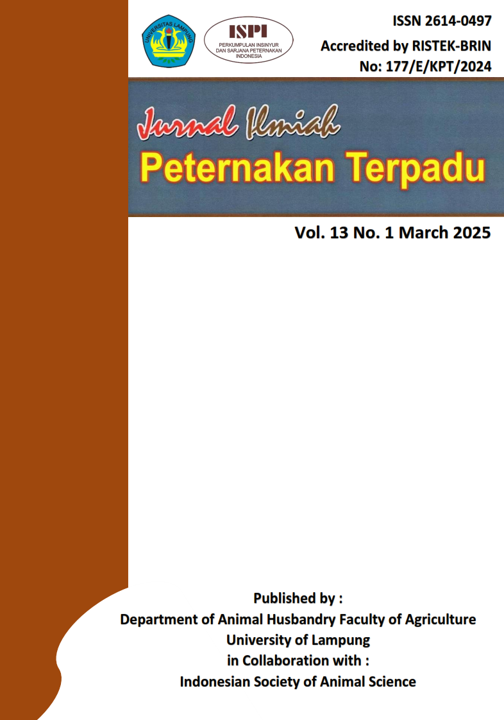Optimization Of Chicken Feather Waste Into High-Protein Chicken Feather Meal
DOI:
https://doi.org/10.23960/jipt.v13i1.p82-97 Abstract View: 466
Abstract View: 466
Keywords:
Chicken Feather Waste, High-Protein Meal, Organoleptic Test, Proximate AnalysisAbstract
This study aims to process chicken feather waste into high-protein feather meal using a completely randomized design (CRD) experimental model. Four processing methods were applied: physical (P1), chemical with 12% HCl (P2), enzymatic with 0.4% proteolytic enzyme (P3), and chemical with 6% NaOH (P4). Proximate analysis included crude fiber, protein, moisture, ash, and fat content. An organoleptic test evaluated the color, texture, and odor of the meal. ANOVA and DMRT at the 5% level indicated significant differences between methods. The chemical method with 6% NaOH yielded the highest protein content (50.1%). Organoleptic data showed that all samples had similar sensory characteristics. The study concludes that the chemical processing method with 6% NaOH is the most effective in enhancing protein content, providing an optimal solution for economically and environmentally utilizing chicken feather waste.Downloads
References
Afriani, D. T., and Hasan, U. 2020. Analisis Proksimat Pakan Buatan dengan Penambahan Hidrolisat Tepung Bulu Ayam sebagai Sumber Protein Alternatif Bagi Ikan Nila (Oreochromis sp.). EKSAKTA : Jurnal Penelitian dan Pembelajaran MIPA 5(2): 186–190.
Andriani, Y., Pratama, R. I., and Hanidah, I. I. 2024. A Review on Chicken Feather Flour Potential for Fish Feed. Torani Journal of Fisheries and Marine Science 7(2): 171–180. DOI: 10.35911/torani.v7i2.34396
Badan Standardisasi Nasional (BSN). 1992. Cara uji makanan dan minuman (SNI 01-2891-1992). Badan Standardisasi Nasional (BSN), Jakarta.
Farida, I., Febrianti, D., and Mahaputra, I. G. I. A. D. 2023. Pengujian Kandungan Bakteri Salmonella sp. pada Ikan Tuna (Thunnus sp.) Menggunakan Metode Real-time PCR (Polymerase Chain Reaction). Marinade 6(1): 40–46. DOI: 10.31629/marinade.v6i01.5110
Fitriana, W. D., Bakri, B., Masrur, M., Qomariana, A., and Anugrah, C. S. 2024a. Pembuatan Pakan Ikan dengan Probiotik sebagai Pakan Alternatif Berstandar SNI. Journal of Fisheries and Marine Research 8(1): 1–7.
Fitriana, W. D., Bakri, Masrur, M., Qomariana, A., and Anugrah, C. S. 2024b. Effect of probiotics addition on artificial feed for catfish growth. Proceeding International Seminar of Science and Technology 3: 151–156. DOI: 10.33830/isst.v3i1.2303
Hanafiah, A. K. 2014. Rancangan Percobaan Teori dan Aplikasi. Rajawali Pers, Jakarta.
Ispitasari, R., and Haryanti. 2022. Pengaruh Waktu Destilasi terhadap Ketepatan Uji Protein Kasar pada Metode Kjeldahl dalam Bahan Pakan Ternak Berprotein Tinggi. Indonesian Journal of Laboratory 5(1): 39–43. DOI: 10.22146/ijl.v0i0.73468
Kementerian Pertanian Indonesia. 2022. Statistik Peternakan dan Kesehatan Hewan. Kementerian Pertanian Indonesia, Jakarta.
Lamiyah, Istyadji, M., and Hafizah, E. 2022. Pengaruh Pemberian Pakan Ternak Bersumber Protein Hewani dan Protein Nabati Terhadap Pertumbuhan Itik Peking. JUSTER : Jurnal Sains dan Terapan 1(3): 72–77. DOI: 10.57218/juster.v1i3.360
Mulia, D. S., Nartanti, Y., Maryanto, H., and Purbomartono, C. 2014. Fermentasi Tepung Bulu Ayam dengan Bacillus Licheniformis B2560 Untuk Meningkatkan Kualitas Bahan Baku Pakanikan. Proceeding Biology Education Conference: Biology, Science, Enviromental, and Learning 11(1): 234–240.
Mulia, D. S., Yuliningsih, R. T., Maryanto, H., and Purbomartono, C. 2016. Pemanfaatan Limbah Bulu Ayam Menjadi Bahan Pakan Ikan dengan Fermentasi Bacillus subtilis (Utilization of Waste Chicken Feather to Fish Feed Ingredients Material with Fermentation of Bacillus subtilis). Jurnal Manusia dan Lingkungan 23(1): 49. DOI: 10.22146/jml.18773
Primadona, F., Wardoyo, S. E., and Hasan, O. D. S. 2013. Kecernaan Protein Biji Kapuk (Ceiba petandra G) Secara In Vitro untuk Pakan Ikan. Jurnal Sains Natural Universitas Nusa Bangsa 3(2): 112–128. DOI: 10.31938/jsn.v3i2.61
Puastuti, W. 2007. Teknologi Pemrosesan Bulu Ayam dan Pemanfaatannya Sebagai Sumber Protein Pakan Ruminansia. Wartazoa 17(2): 53–60.
Puastuti, W., Yulistiani, D., and Mathius, I.-W. 2004. Nilai Biologis (In Vitro dan In Sacco) Bulu Ayam yang Diolah secara Kimiawi sebagai Sumber Protein By-Pass Rumen. Jitv 9(2): 73–81.
Rahayu, S., Bata, M., and Hadi, W. 2014. Substitusi Konsentrat Protein Menggunakan Tepung Bulu Ayam yang Diolah Secara Fisiko-Kimia dan Fermentasi Menggunakan Bacillus sp. Mts. Jurnal Agripet 14(1): 31–36. DOI: 10.17969/agripet.v14i1.1202
Sayuti, M., Dewi, L. R., and Sofian, A. 2022. Karakteristik Fisiko-Kimia Dan Proses Produksi Pakan Apung Ikan Lele (Clarias sp.). Pelagicus 3(1): 17. DOI: 10.15578/plgc.v3i1.10485
Siregar, N., Rasyidah, and Mayasari, U. 2024. Penggunaan Bakteri Bacillus subtilis pada Limbah Bulu Ayam Potong sebagai Bahan Pakan Ternak Ikan Lele (Clarias gariepinus). 6(1): 648–660.
Sugiyono. 2010. Metode penelitian kuantitatif kualitatif dan R&D. Alfabeta, Bandung.
Zaenuri, R., Suharto, B., and Haji, A. T. S. 2014. Kualitas Pakan Ikan Berbentuk Pelet Dari Limbah Pertanian. Jurnal Sumberdaya Alam & Lingkungan 1(1): 31–36.
Downloads
Published
How to Cite
Issue
Section
License

Jurnal Ilmiah Peternakan Terpadu(JIPT) is licensed under a Creative Commons Attribution 4.0 International License.
Authors who publish with this journal agree to the following terms:
- Authors retain copyright and grant the journal right of first publication with the work simultaneously licensed under a Creative Commons Attribution License that allows others to share the work with an acknowledgement of the work's authorship and initial publication in this journal.
- Authors are able to enter into separate, additional contractual arrangements for the non-exclusive distribution of the journal's published version of the work (e.g., post it to an institutional repository or publish it in a book), with an acknowledgement of its initial publication in this journal.
- Authors are permitted and encouraged to post their work online (e.g., in institutional repositories or on their website) prior to and during the submission process, as it can lead to productive exchanges, as well as earlier and greater citation of published work (See The Effect of Open Access).





















